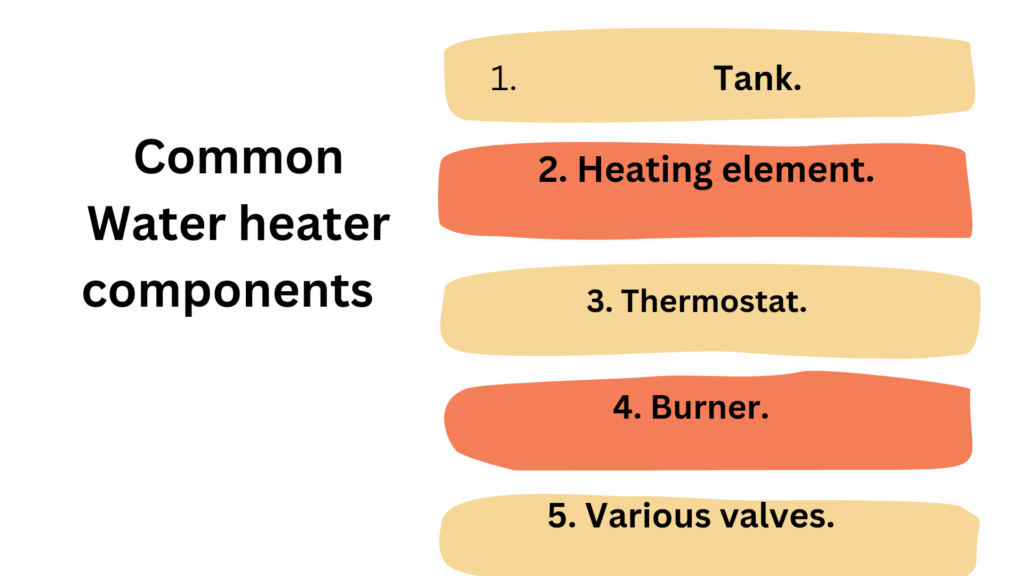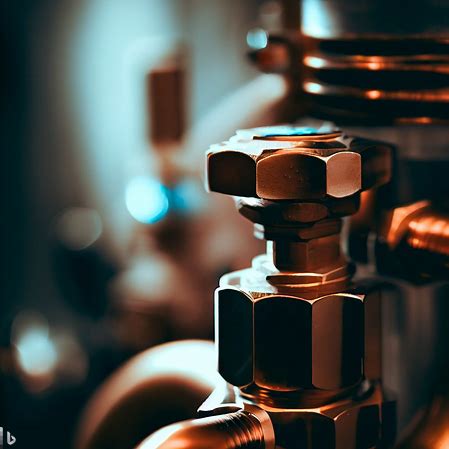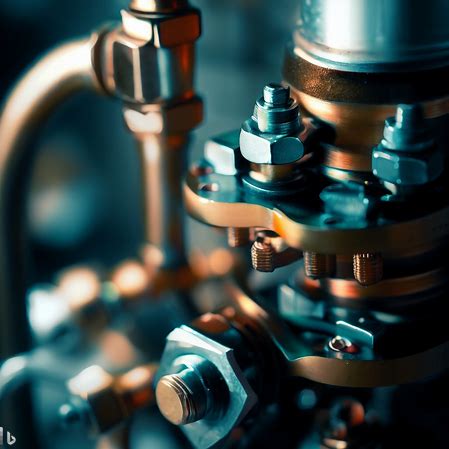Table of Contents
Water heaters have essential components to keep them running smoothly. This includes gas, electric, solar, tankless & heat pump heaters. These components are key to heating water efficiently and providing a steady supply of hot water.
The main parts are:
- the tank
- the heating element
- thermostat
- burner (for gas heaters)
- various valves including the gas control & relief valves
The tank is where the water is stored and heated – plus a dip tube to make sure cold water goes in the bottom and hot water comes out the top.
Gas water heaters have a burner to ignite the fuel and heat up the tank. The thermostat monitors and controls the temp – while the gas control valve regulates the flow of gas to maintain the desired temperature. The relief valve releases any excess pressure if it builds up inside the tank.
Electric heaters have heating elements that heat up with electric current. These are controlled by a circuit board that regulates their operation. Other important components include pipes for water flow, vents for exhausting combustion gases in gas heaters, flue pipes and thermocouples/thermopiles as safety devices to shut off gas supply if needed.
Regular maintenance of water heater components will help extend their lifespan. Plus, keeping flammable vapors away from gas heaters is important for safety. Knowing all these components will help you troubleshoot and keep your water heater running optimally.
Common Water Heater Components

Water heaters need components to work properly! These include the gas valve, thermostat, burner, pilot light, relief valve and more. They all function together to heat water and maintain the temperature you set. The gas valve controls the flow of gas to the burner, the thermostat adjusts the water temperature, the burner burns fuel to heat the water in the tank and the pilot light provides a continuous flame.
The relief valve releases excess pressure to stop tank damage and the dip tube directs cold water to the bottom of the tank. Solar & tankless water heaters need extra parts; solar panels, circulation pumps & circuit boards, sensors etc. Early water heaters didn’t have these modern components. Instead they used fire or steam.
Understanding the components makes it easier to troubleshoot issues and repair/replace them. So, next time you enjoy that hot shower, you can thank all the intricate components working to provide you with comfort and convenience!
Components Specific to Different Types of Water Heaters

Components specially-made for different types of water heaters are essential for their efficient functioning. It’s important to know the components that are unique for each type, such as gas, electric, solar, and tankless. These are listed in the table below:
| Component | Gas Water Heater | Electric Hot Water Heater | Solar Water Heater | Tankless Water Heater |
|---|---|---|---|---|
| Gas Valve | Yes | No | No | No |
| Heating Element | No | Yes | No | No |
| Heat Pump | No | No | Yes | No |
| Immersion Heater | No | Yes | No | Yes |
In addition to these components, each water heater type has its own unique features. For example, gas water heaters have a pilot light and a combustion chamber. Electric water heaters have heating elements that heat up the water directly. Solar water heaters use solar panels or collectors to absorb sunlight and heat the water. Tankless water heaters don’t have a storage tank and use heating elements or burners to supply hot water when needed.
To guarantee the best performance and safety of your water heater, here are a few tips:
- Schedule regular maintenance checks.
- Set the temperature according to your needs and don’t set it too high.
- Replace worn-out parts immediately.
- Insulate the hot water pipes and storage tank.
- Follow the manufacturer’s instructions.
By following these guidelines, you can be sure that your water heater works well, giving you a reliable source of hot water without any breakdowns or safety risks.
How Water Heater Components Work Together
Water heater components work together to provide hot water. These include the heating elements, thermostat, burner, pilot light, tank, control valves, and temperature/pressure relief valve.
Here’s how they work:
- Heating Elements: Gas or electric elements that heat the water inside the tank.
- Thermostat: Controls the water temperature by turning on/off the heating elements.
- Burner: Ignites the gas to heat the water in gas water heaters.
- Pilot Light: Keeps a small flame burning to ignite the burner when needed.
- Tank: Stores the heated water until it’s needed.
- Control Valves: Allow for manual adjustment of gas/water flow in/out of the tank.
- Relief Valve: Releases excess pressure if overheating/over pressurization occurs.
Plus, there are smaller parts like dip tubes, thermocouples, igniters, flue pipes, and drain valves that help the water heater.
For optimal performance and longevity, follow these tips:
- Maintenance: Flush the tank at least once a year to remove sediment. Check all fittings for leaks.
- Temperature settings: Lower the hot water temperature to save energy and avoid scalding accidents.
- Insulate pipes: Reduces heat loss during distribution and conserves energy.
- Install a timer: Set specific times for your water heater to operate—avoid unnecessary heating during low demand.
- Upgrade: Invest in a newer model for energy savings.
By following these steps, you’ll get the most out of your hot water supply while reducing energy consumption and potential issues. Troubleshooting and Common Issues: Where water heater components go to have their hot streaks cut short.
Troubleshooting and Common Issues Water Heater

Having trouble with your water heater? No stress! Here are some common issues and helpful tips.
– Leaking: Water pooling? Check for loose connections or valves. Still leaking? Call a pro.
– No hot water: Gas water heater? Check the pilot light. Electric? Check the circuit breaker. Not working? Pro time.
– Inadequate hot water: Try adjusting the thermostat higher. Flush the tank to remove sediment buildup.
If these don’t work, it’s best to call an expert. Pro Tip: Regular maintenance can help your water heater last longer. Flush the tank and check for leaks annually.
No more icy showers! Water heater components may be complicated, but they keep us cozy.
Frequently Asked Questions
What are the main components of a water heater?
Answer: The main components of a water heater include the tank, heating elements (gas burner or electric heating elements), thermostat, temperature and pressure relief valve, inlet and outlet pipes, drain valve, and anode rod.
How does a gas water heater work?
Answer: A gas water heater works by using a gas burner to heat the water. The gas burner ignites and heats the combustion chamber, which then transfers heat to the water through a copper tube or heat exchanger. The heated water then rises to the top of the tank for use.
What are the components of a solar water heater?
Answer: The components of a solar water heater include solar collectors (usually mounted on the roof to absorb sunlight), an insulated storage tank, a heat transfer fluid or water circulation system, a backup heating element or gas burner, and pipes or tubing to transfer hot water to the desired location.
What are the components of a tankless water heater?
Answer: Tankless water heaters have fewer components compared to traditional tank-style water heaters. The main components of a tankless water heater include a heat exchanger, burner or heating element, flow sensor, temperature sensors, thermostat, and a control module or circuit board for managing the heating process.
How does an electric hot water heater work?
Answer: Electric hot water heaters use heating elements, typically made of metal alloy, to heat the water. When the thermostat senses the water temperature is below the set point, it sends an electric current to the heating elements. The elements then generate heat, which transfers to the water through direct contact.
Where can I find water heater parts near me?
Answer: You can find water heater parts at local hardware stores, plumbing supply stores, or home improvement centers. Online retailers and manufacturers’ websites also offer a wide selection of water heater parts, allowing you to conveniently order them from the comfort of your home.
Conclusion
To finish off, components of water heaters are very essential for the functioning and safety of these machines. From valves to thermostats, each part contributes to heat production and dispersal. It’s important to understand them to keep and repair water heaters well.
The gas control valve is paramount; it controls the flow of fuel to the combustion chamber. The thermostat takes charge of temperature settings and keeps them within a safe range. The dip tube sends cold water to the tank’s base for heating.
The thermocouple is a special component; it creates electric current when heated by the pilot flame. This current keeps the gas valve open and running.
It’s worth noting that malfunctioning water heater parts could lead to serious hazards, such as gas leaks or too much pressure. According to an NREL study, upkeep and inspections are necessary to avoid accidents due to water heater components.
